
|
Now it is 8.9 mag (Feb. 21, Carlos Labordena). It stays bright as 8-9 mag until July. It is observable in good condition in the Northern Hemisphere. In the Southern Hemisphere, it is not observable until July.
Date(TT) R.A. (2000) Decl. Delta r Elong. m1 Best Time(A, h)
Mar. 7 2 13.87 62 28.0 1.756 1.798 76 8.6 19:24 (146, 43)
Mar. 14 2 22.22 63 58.9 1.767 1.759 73 8.6 19:30 (148, 40)
|

|
Now it is bright as 9.7 mag (Feb. 21, Carlos Labordena). It stays bright as 9 mag until late April. In the Northern Hemisphere, it stays observable for a long time, although it becomes extremely low in March. In the Southern Hemisphere, it is not observable until June when it fades down to 13 mag. It seems to be a fragment of C/1988 A1 (Liller), like C/1996 Q1 (Tabur) and C/2015 F3 (SWAN).
Date(TT) R.A. (2000) Decl. Delta r Elong. m1 Best Time(A, h)
Mar. 7 0 0.23 22 50.5 1.540 0.852 30 9.4 19:24 (113, 8)
Mar. 14 0 3.97 29 6.4 1.487 0.837 32 9.2 19:30 (122, 6)
|

|
Brightening very rapidly. Now it is very bright as 11.5 mag (Feb. 28, Michael Jager). It moves along the same orbit as C/1844 Y1 (Great Comet). It approaches to Sun down to 0.25 a.u. on May 30. It is expected to brighten up to 1 mag. In the Northern Hemisphere, it stays observable in excellent condition until mid May when it brightens up to 5 mag. In the Southern Hemisphere, it is not observable until June.
Date(TT) R.A. (2000) Decl. Delta r Elong. m1 Best Time(A, h)
Mar. 7 10 38.96 61 54.5 1.173 1.906 123 10.6 23:34 (180, 63)
Mar. 14 10 2.18 65 12.0 1.125 1.789 115 10.3 22:29 (180, 60)
|
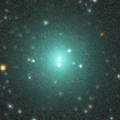
|
Now it is very bright as 10.6 mag (Feb. 21, Maik Meyer). It will be fading gradually after this. It is observable in good condition in the Northern Hemisphere. It is not observable in the Southern Hemisphere.
Date(TT) R.A. (2000) Decl. Delta r Elong. m1 Best Time(A, h)
Mar. 7 2 36.06 75 22.5 1.040 1.388 86 11.5 19:24 (163, 43)
Mar. 14 4 15.24 67 4.8 1.177 1.468 84 12.0 19:30 (156, 51)
|

|
Now it is 13.3 mag (Feb. 28, Sandor Szabo). It stays bright as 12-13 mag until summer. But it becomes low in spring. In the Southern Hemisphere, it will never be observable again.
Date(TT) R.A. (2000) Decl. Delta r Elong. m1 Best Time(A, h)
Mar. 7 0 2.14 48 0.7 3.800 3.324 54 12.6 19:24 (134, 22)
Mar. 14 0 8.67 49 28.5 3.858 3.347 52 12.6 19:30 (138, 19)
|

|
It brightened in outburst on Feb. 3. It is bright as 13.0 mag still now (Feb. 18, Toshihiko Ikemura, Hirohisa Sato). It is already unobservable in the Southern Hemisphere. It will be unobservable in mid March also in the Northern Hemisphere.
Date(TT) R.A. (2000) Decl. Delta r Elong. m1 Best Time(A, h)
Mar. 7 1 4.68 15 28.2 6.576 5.792 35 13.8 19:24 ( 98, 17)
Mar. 14 1 9.85 15 56.0 6.637 5.793 29 13.8 19:30 (102, 11)
|
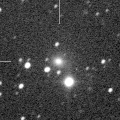
|
Now it is bright as 13.8 mag (Dec. 28, Chris Wyatt). It stays 14 mag until spring. It stays observable for a long time in the Southern Hemisphere. It is not observable until August in the Northern Hemisphere.
Date(TT) R.A. (2000) Decl. Delta r Elong. m1 Best Time(A, h)
Mar. 7 1 34.67 -56 19.1 3.965 3.548 58 14.3 19:24 ( 35,-20)
Mar. 14 1 43.57 -53 55.9 3.997 3.564 57 14.4 19:30 ( 39,-22)
|

|
Now it is 15.9 mag (Dec. 26, M. Mattiazzo). In the Southern Hemisphere, it is observable at 14.5 mag from winter to spring. In the Northern Hemisphere, it is not observable until August when it fades down to 17 mag.
Date(TT) R.A. (2000) Decl. Delta r Elong. m1 Best Time(A, h)
Mar. 7 2 18.08 -53 33.1 2.311 2.032 61 14.4 19:24 ( 33,-13)
Mar. 14 2 39.28 -48 43.8 2.344 2.045 60 14.5 19:30 ( 38,-11)
|
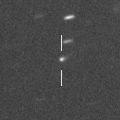
|
Now it is 14.9 mag (Feb. 22, Toshihiko Ikemura, Hirohisa Sato). It will brighten up to 13.5-14 mag from 2020 to 2021. It stays observable in good condition for a while.
Date(TT) R.A. (2000) Decl. Delta r Elong. m1 Best Time(A, h)
Mar. 7 13 12.21 15 21.1 2.502 3.388 148 14.6 2:13 ( 0, 70)
Mar. 14 13 8.73 15 58.3 2.451 3.371 153 14.5 1:42 ( 0, 71)
|
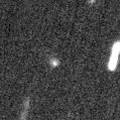
|
Now it is 14.9 mag (Feb. 27, Toshihiko Ikemura, Hirohisa Sato). It will brighten up to 10.5 mag from 2020 December to 2021 January. In the Northern Hemisphere, it stays observable in good condition while the comet will be brightening gradually, but it is not observable at the high light. In the Southern Hemisphere, it is not observable for a long time, but it will be observable in good condition after the high light.
Date(TT) R.A. (2000) Decl. Delta r Elong. m1 Best Time(A, h)
Mar. 7 18 43.73 67 35.7 3.577 3.650 86 14.9 4:57 (203, 50)
Mar. 14 18 43.79 69 15.0 3.505 3.585 86 14.8 4:48 (199, 50)
|

|
It has not been observed yet in this apparition. The condition of this apparition is bad, and it it not observable before the perihelion passage. It will appear in the morning sky at 12 mag in mid April in the Northern Hemisphere, or at 15 mag in mid May in the Southern Hemisphere. However, it will fade out rapidly, and will be fainter than 18 mag in June.
Date(TT) R.A. (2000) Decl. Delta r Elong. m1 Best Time(A, h)
Mar. 7 23 41.53 -7 8.5 1.808 0.837 7 15.9 19:24 ( 90,-13)
Mar. 14 0 11.54 -3 31.8 1.705 0.739 8 14.9 19:30 ( 94,-11)
|

|
Now it is very bright as 14.4 mag (Feb. 14, Taras Prystavski). Taras Prystavski reported it has a coma of 1.5 arcmin. It will approach to Sun down to 0.9 a.u. in June, and it is extected to brighten up to 10 mag. In the Southern Hemisphere, it stays observable in good condition for a long time after this. In the Northern Hemisphere, it will be unobservable from late March to late June.
Date(TT) R.A. (2000) Decl. Delta r Elong. m1 Best Time(A, h)
Mar. 7 3 57.90 -25 26.7 2.002 1.929 71 15.4 19:24 ( 35, 20)
Mar. 14 4 1.60 -24 54.7 1.975 1.840 67 15.1 19:30 ( 42, 17)
|
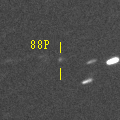
|
Now it is 15.8 mag (Feb. 23, Toshihiko Ikemura, Hirohisa Sato). Brightening very rapidly. It will brighten up to 8-9 mag from summer to autumn. It will be observable in excellent condition in the Southern Hemisphere. It locates very low around the high light in the Northern Hemisphere.
Date(TT) R.A. (2000) Decl. Delta r Elong. m1 Best Time(A, h)
Mar. 7 13 42.67 -5 23.1 1.549 2.400 140 15.6 2:44 ( 0, 50)
Mar. 14 13 40.60 -5 6.2 1.451 2.354 148 15.2 2:14 ( 0, 50)
|
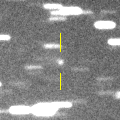
|
First return of a new periodic comet discovered in 2006. It brightened up to 14.9 mag in January (Jan. 21, R. Fichtl). It will never be observable after this.
Date(TT) R.A. (2000) Decl. Delta r Elong. m1 Best Time(A, h)
Mar. 7 0 27.80 -5 57.8 2.614 1.708 19 15.6 19:24 ( 85, -3)
Mar. 14 0 47.14 -4 28.1 2.622 1.702 17 15.6 19:30 ( 88, -5)
|

|
Now it is 16.1 mag (Feb. 20, Toshihiko Ikemura, Hirohisa Sato). It will brighten up to 13 mag in 2021. In 2020, it is observable at 15 mag in good condition from spring to summer.
Date(TT) R.A. (2000) Decl. Delta r Elong. m1 Best Time(A, h)
Mar. 7 15 1.19 -16 47.7 4.912 5.462 118 15.8 4:02 ( 0, 38)
Mar. 14 14 59.44 -17 15.9 4.773 5.419 126 15.7 3:33 ( 0, 38)
|

|
Now it is 15.4 mag (Feb. 20, Toshihiko Ikemura, Hirohisa Sato). It is expected to be observable at 5-6 mag for a long time from 2022 to 2023. In the Northern Hemisphere, it is not observable at the high light from 2022 summer to 2023 summer. In the Southern Hemisphere, it stays unobservable for a while. But it will be observable in good condition at the high light.
Date(TT) R.A. (2000) Decl. Delta r Elong. m1 Best Time(A, h)
Mar. 7 18 17.00 47 55.1 9.729 9.658 82 15.8 4:57 (233, 61)
Mar. 14 18 18.21 48 25.8 9.644 9.609 85 15.7 4:48 (230, 64)
|

|
Now it is 14.6 mag (Dec. 28, Chris Wyatt). It will be fading slowly after this. In the Southern Hemisphere, it becomes low from February to March, but it stays observable for a long time. In the Northern Hemisphere, it is not observasble until June.
Date(TT) R.A. (2000) Decl. Delta r Elong. m1 Best Time(A, h)
Mar. 7 23 21.89 -40 55.0 4.410 3.651 35 15.9 19:24 ( 60,-33)
Mar. 14 23 28.20 -39 31.0 4.429 3.684 37 15.9 4:48 (297,-34)
|

|
It brightened up to 7.7 mag in June in 2018 (June 19, Juan Jose Gonzalez). Now it is fading. It has already faded down to 15.8 mag (Feb. 18, Toshihiko Ikemura, Hirohisa Sato). In the Southern Hemisphere, it stays observable for a long time until the comet will fade out. In the Northern Hemisphere, it stays low for a while.
Date(TT) R.A. (2000) Decl. Delta r Elong. m1 Best Time(A, h)
Mar. 7 5 30.37 -21 47.5 6.020 6.145 92 16.0 19:24 ( 15, 32)
Mar. 14 5 30.48 -20 36.4 6.160 6.200 87 16.1 19:30 ( 24, 31)
|

|
Now it is 15.5 mag (Feb. 18, Sandor Szabo). It will be fading after this, and will be fainter than 18 mag in May. In the Northern Hemisphere, it is observable in excellent condition. It locates low in the Southern Hemisphere.
Date(TT) R.A. (2000) Decl. Delta r Elong. m1 Best Time(A, h)
Mar. 7 5 9.15 13 30.8 1.325 1.667 90 16.1 19:24 ( 43, 63)
Mar. 14 5 26.13 12 53.5 1.402 1.691 88 16.3 19:30 ( 49, 60)
|

|
Now it is 15.8 mag (Oct. 5, Toshihiko Ikemura, Hirohisa Sato). It stays 15-16 mag for a long time until 2021.
Date(TT) R.A. (2000) Decl. Delta r Elong. m1 Best Time(A, h)
Mar. 7 20 47.09 -7 12.3 5.320 4.551 35 16.2 4:57 (286, 10)
Mar. 14 20 49.46 -6 0.9 5.234 4.541 41 16.2 4:48 (288, 14)
|
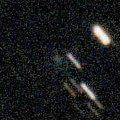
|
Now it is 16.6 mag (Feb. 19, Toshihiko Ikemura, Hirohisa Sato). It stays 16.5 mag until late March. It is not observable in the Southern Hemisphere.
Date(TT) R.A. (2000) Decl. Delta r Elong. m1 Best Time(A, h)
Mar. 7 2 3.48 25 43.2 1.864 1.479 52 16.4 19:24 (100, 34)
Mar. 14 2 24.82 28 28.4 1.909 1.496 50 16.4 19:30 (104, 33)
|

|
It will be fading slowly after this. In the Southern Hemisphere, it stays observable in good condition for a long time. It will never be observable after this in the Northern Hemisphere.
Date(TT) R.A. (2000) Decl. Delta r Elong. m1 Best Time(A, h)
Mar. 7 12 45.39 -76 6.4 4.758 4.984 97 16.4 1:48 ( 0,-21)
Mar. 14 12 11.66 -76 33.8 4.748 5.029 100 16.4 0:47 ( 0,-22)
|
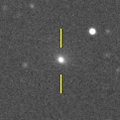
|
Now it is 15.9 mag (Feb. 18, Toshihiko Ikemura, Hirohisa Sato). It will be fading slowly after this.
Date(TT) R.A. (2000) Decl. Delta r Elong. m1 Best Time(A, h)
Mar. 7 2 14.44 9 35.3 2.937 2.392 48 16.4 19:24 ( 82, 28)
Mar. 14 2 27.50 10 50.8 3.009 2.404 44 16.5 19:30 ( 86, 24)
|
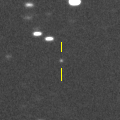
|
Now it is 15.9 mag (Feb. 18, Toshihiko Ikemura, Hirohisa Sato). It will brighten up to 16 mag in March, and it will be observable in good condition.
Date(TT) R.A. (2000) Decl. Delta r Elong. m1 Best Time(A, h)
Mar. 7 10 50.69 37 39.5 0.795 1.716 147 16.5 23:47 (180, 88)
Mar. 14 10 35.40 34 24.0 0.786 1.699 145 16.4 23:04 ( 0, 89)
|

|
Now it is 16.4 mag (Feb. 23, Toshihiko Ikemura, Hirohisa Sato). It stays observable at 17 mag from 2020 to 2021. It locates somewhat low in the Northern Hemisphere.
Date(TT) R.A. (2000) Decl. Delta r Elong. m1 Best Time(A, h)
Mar. 7 10 49.04 -24 8.3 5.715 6.593 150 16.5 23:46 ( 0, 31)
Mar. 14 10 47.07 -23 38.2 5.702 6.591 151 16.5 23:17 ( 0, 31)
|
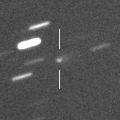
|
Now it is 16.8 mag (Feb. 18, Toshihiko Ikemura, Hirohisa Sato). It brightens up to 16.5 mag and will be observable in good condition from March to April.
Date(TT) R.A. (2000) Decl. Delta r Elong. m1 Best Time(A, h)
Mar. 7 13 33.15 -1 4.4 1.258 2.141 143 16.6 2:34 ( 0, 54)
Mar. 14 13 31.58 -0 45.7 1.223 2.148 151 16.6 2:05 ( 0, 54)
|
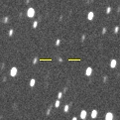
|
Now it is 17.2 mag (Feb. 20, Toshihiko Ikemura, Hirohisa Sato). It will stay at 14 mag for a long time from 2021 to 2022. In the Northern Hemisphere, it stays observable in good condition while brightening gradually. In the Southern Hemisphere, it is appearing in the morning sky. But it stays locating low for a long time.
Date(TT) R.A. (2000) Decl. Delta r Elong. m1 Best Time(A, h)
Mar. 7 19 13.81 30 27.0 7.069 6.741 66 16.7 4:57 (262, 49)
Mar. 14 19 14.98 30 46.6 6.975 6.708 70 16.6 4:48 (263, 52)
|

|
It looks cometary on the LCO (CTIO) image on Aug. 21, 2019. Now it is 16.2 mag (Oct. 2, ATLAS-MLO, Mauna Loa). It is appearing in the mornign sky in the Southern Hemisphere. It will be observable in late March also in the Northern Hemisphere.
Date(TT) R.A. (2000) Decl. Delta r Elong. m1 Best Time(A, h)
Mar. 7 20 10.50 -30 40.7 7.133 6.529 49 16.7 4:57 (310, 1)
Mar. 14 20 11.11 -30 28.8 7.043 6.538 55 16.7 4:48 (312, 4)
|
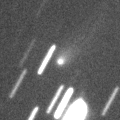
|
Now it is 16.2 mag (Jan. 21, Thomas Lehmann). The orbit is extremely hyperbolic with e=3.35. It is the first interstellar comet in history. It will be fading after this, and will be fainter than 18 mag in April. In the Southern Hemisphere, it is observable in excellent condition. In the Northern Hemisphere, it will never be observable again.
Date(TT) R.A. (2000) Decl. Delta r Elong. m1 Best Time(A, h)
Mar. 7 12 57.18 -67 11.4 2.386 2.812 105 16.9 1:59 ( 0,-12)
Mar. 14 12 54.43 -68 26.3 2.460 2.921 107 17.1 1:28 ( 0,-13)
|

|
Now it is 15.9 mag (Feb. 18, Toshihiko Ikemura, Hirohisa Sato). It will be fading gradually after this. It will be fainter than 18 mag in April.
Date(TT) R.A. (2000) Decl. Delta r Elong. m1 Best Time(A, h)
Mar. 7 8 52.05 9 19.1 2.319 3.186 145 16.9 21:50 ( 0, 64)
Mar. 14 8 49.75 9 46.8 2.410 3.218 137 17.1 21:20 ( 0, 65)
|
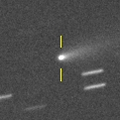
|
Now it is 16.0 mag (Feb. 17, Toshihiko Ikemura, Hirohisa Sato). It will fade out rapidly after this, and it will be fainter than 18 mag in late March.
Date(TT) R.A. (2000) Decl. Delta r Elong. m1 Best Time(A, h)
Mar. 7 11 16.59 16 29.5 1.186 2.168 168 17.1 0:18 ( 0, 71)
Mar. 14 11 12.64 16 50.9 1.234 2.208 164 17.5 23:42 ( 0, 72)
|
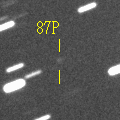
|
Now it is 17.4 mag (Feb. 20, Toshihiko Ikemura, Hirohisa Sato). It will brighten up to 17 mag and will be observable in excellent condition from March to May.
Date(TT) R.A. (2000) Decl. Delta r Elong. m1 Best Time(A, h)
Mar. 7 12 59.84 -6 17.1 1.231 2.151 150 17.3 2:01 ( 0, 49)
Mar. 14 12 58.01 -5 51.9 1.186 2.140 157 17.2 1:32 ( 0, 49)
|

|
Now it is 17.8 mag (Feb. 20, Toshihiko Ikemura, Hirohisa Sato). It will be fading slowly after this, and will be fainter than 18 mag in 2021. It is observable in good condition in the Northern Hemisphere. In the Southern Hemisphere, it is observable in the extremely low sky only in 2021 spring.
Date(TT) R.A. (2000) Decl. Delta r Elong. m1 Best Time(A, h)
Mar. 7 13 19.56 55 55.8 8.146 8.729 123 17.2 2:20 (180, 69)
Mar. 14 13 15.83 56 4.8 8.160 8.740 122 17.2 1:49 (180, 69)
|
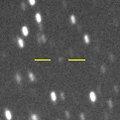
|
Now it is 17.4 mag (Feb. 23, Toshihiko Ikemura, Hirohisa Sato). It is expected to brighten up to 13 mag in 2022. In 2020, it is observable in excellent condition in the Southern Hemisphere. In the Northern Hemisphere, it will be unobservable soon. It will be observable again from autumn to winter, but it locating extremely low.
Date(TT) R.A. (2000) Decl. Delta r Elong. m1 Best Time(A, h)
Mar. 7 6 7.97 -32 26.6 7.466 7.686 99 17.4 19:24 ( 4, 22)
Mar. 14 6 8.41 -31 47.6 7.487 7.645 95 17.3 19:30 ( 12, 22)
|

|
Now it is 17.6 mag (Feb. 3, ATLAS-HKO, Haleakala). It brightened up to 14 mag from autumn to winter in 2018. Now it is fading. It is observable at 17.5 mag in good condition from winter to spring.
Date(TT) R.A. (2000) Decl. Delta r Elong. m1 Best Time(A, h)
Mar. 7 13 35.85 -3 18.4 3.711 4.541 142 17.5 2:37 ( 0, 52)
Mar. 14 13 31.16 -3 16.8 3.687 4.581 150 17.4 2:05 ( 0, 52)
|

|
Now it is 17.8 mag (Feb. 17, Toshihiko Ikemura, Hirohisa Sato). It will brighten up to 13 mag in 2022. In 2020, it is observable at 17.5 mag in good condition in spring. It locates somewhat low in the Southern Hemisphere.
Date(TT) R.A. (2000) Decl. Delta r Elong. m1 Best Time(A, h)
Mar. 7 10 26.61 21 33.8 3.579 4.527 160 17.6 23:24 ( 0, 76)
Mar. 14 10 22.39 21 50.0 3.602 4.514 153 17.6 22:52 ( 0, 77)
|

|
It will be observable at 16.5-17 mag from spring in 2020 to summer in 2021.
Date(TT) R.A. (2000) Decl. Delta r Elong. m1 Best Time(A, h)
Mar. 7 20 1.96 20 8.1 5.553 5.017 52 17.6 4:57 (268, 35)
Mar. 14 20 2.86 20 25.2 5.465 4.996 57 17.6 4:48 (270, 38)
|

|
It will brighten up to 15.5 mag and will be observable in good condition from June to September.
Date(TT) R.A. (2000) Decl. Delta r Elong. m1 Best Time(A, h)
Mar. 7 18 49.29 -7 56.6 2.812 2.555 64 17.7 4:57 (308, 31)
Mar. 14 19 0.44 -6 54.7 2.711 2.529 68 17.6 4:48 (309, 33)
|

|
Now it is 20.6 mag (Feb. 4, Pan-STARRS 1, Haleakala). It will brighten rapidly, and will brighten up to 9.5 mag in June. It is not observable in June. However, it stays observable in good condition until May while the comet is brightening, and after July while the comet will be fading.
Date(TT) R.A. (2000) Decl. Delta r Elong. m1 Best Time(A, h)
Mar. 7 11 48.23 -15 19.1 0.967 1.922 157 18.1 0:50 ( 0, 40)
Mar. 14 11 35.29 -14 46.4 0.868 1.841 162 17.6 0:10 ( 0, 40)
|

|
Now it is 17.8 mag (Feb. 23, Toshihiko Ikemura, Hirohisa Sato). It stays observable at 16.5 mag for a long time from 2020 to 2021. In the Northern Hemisphere, it is observable in excellent condition for a long time. In the Southern Hemisphere, it is not observable until 2021 summer.
Date(TT) R.A. (2000) Decl. Delta r Elong. m1 Best Time(A, h)
Mar. 7 1 7.74 69 10.8 6.608 6.460 77 17.7 19:24 (154, 36)
Mar. 14 1 12.02 68 32.4 6.662 6.441 72 17.7 19:30 (154, 33)
|

|
Fading. Now it is 18.3 mag (Feb. 18, Toshihiko Ikemura, Hirohisa Sato). It stays observable in good condition for a while.
Date(TT) R.A. (2000) Decl. Delta r Elong. m1 Best Time(A, h)
Mar. 7 7 50.33 23 17.0 6.530 7.191 128 17.8 20:48 ( 0, 78)
Mar. 14 7 46.61 23 5.3 6.676 7.235 120 17.8 20:17 ( 0, 78)
|

|
Fading. Now it is 18.0 mag (Feb. 26, Hidetaka Sato). It will be fainter than 18 mag soon.
Date(TT) R.A. (2000) Decl. Delta r Elong. m1 Best Time(A, h)
Mar. 7 17 47.38 -5 15.0 2.909 2.913 80 17.8 4:57 (322, 42)
Mar. 14 17 53.92 -4 31.1 2.866 2.958 85 17.8 4:48 (324, 44)
|
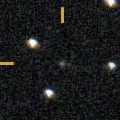
|
Now it is 17.5 mag (Feb. 18, Toshihiko Ikemura, Hirohisa Sato). It is observable at 17-18 mag for a long time from late 2019 to early 2021. It will fade out before it passes the perihelion.
Date(TT) R.A. (2000) Decl. Delta r Elong. m1 Best Time(A, h)
Mar. 7 3 8.92 6 35.9 5.371 4.960 60 17.8 19:24 ( 70, 37)
Mar. 14 3 13.36 7 13.6 5.450 4.947 54 17.8 19:30 ( 76, 31)
|

|
Now it is 17.6 mag (Feb. 18, Toshihiko Ikemura, Hirohisa Sato). It will be fainter than 18 mag in late April.
Date(TT) R.A. (2000) Decl. Delta r Elong. m1 Best Time(A, h)
Mar. 7 12 41.64 9 30.0 9.866 10.787 157 17.8 1:43 ( 0, 64)
Mar. 14 12 40.34 9 49.3 9.852 10.804 162 17.8 1:14 ( 0, 65)
|
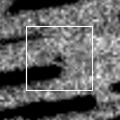
|
It is observable at 17.5 mag in good condition in spring.
Date(TT) R.A. (2000) Decl. Delta r Elong. m1 Best Time(A, h)
Mar. 7 17 43.83 -17 51.1 2.250 2.305 80 17.8 4:57 (330, 31)
Mar. 14 17 52.87 -17 47.8 2.193 2.332 85 17.9 4:48 (332, 32)
|
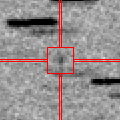
|
Now it is 18.6 mag (Feb. 23, Toshihiko Ikemura, Hirohisa Sato). It will brighten up to 15.5 mag from June to August, and it will be observable in good condition.
Date(TT) R.A. (2000) Decl. Delta r Elong. m1 Best Time(A, h)
Mar. 7 17 49.61 -12 32.5 2.365 2.390 79 18.0 4:57 (326, 35)
Mar. 14 18 1.14 -12 0.7 2.259 2.362 83 17.9 4:48 (327, 37)
|

|
It passed the perihelion on Jan . 17. Now it is fading very rapidly. But it is observable in excellent condition.
Date(TT) R.A. (2000) Decl. Delta r Elong. m1 Best Time(A, h)
Mar. 7 6 26.31 5 10.0 0.645 1.350 109 20.4 19:26 ( 0, 60)
Mar. 14 6 44.81 8 16.0 0.825 1.468 107 21.2 19:30 ( 8, 63)
|
|
![]()
 A/2019 U6
A/2019 U6 88P/Howell
88P/Howell 390P/2019 U1 ( Gibbs )
390P/2019 U1 ( Gibbs ) C/2019 F1 ( ATLAS-Africano )
C/2019 F1 ( ATLAS-Africano ) C/2017 K2 ( PanSTARRS )
C/2017 K2 ( PanSTARRS ) C/2018 A6 ( Gibbs )
C/2018 A6 ( Gibbs ) C/2016 M1 ( PanSTARRS )
C/2016 M1 ( PanSTARRS ) 114P/Wiseman-Skiff
114P/Wiseman-Skiff C/2019 K7 ( Smith )
C/2019 K7 ( Smith ) 112P/Urata-Niijima
112P/Urata-Niijima C/2017 M4 ( ATLAS )
C/2017 M4 ( ATLAS ) 101P/Chernykh
101P/Chernykh 124P/Mrkos
124P/Mrkos C/2019 C1 ( ATLAS )
C/2019 C1 ( ATLAS ) P/2019 Y2 ( Fuls )
P/2019 Y2 ( Fuls ) C/2018 U1 ( Lemmon )
C/2018 U1 ( Lemmon ) A/2017 U7
A/2017 U7 2I/2019 Q4 ( Borisov )
2I/2019 Q4 ( Borisov ) 78P/Gehrels 2
78P/Gehrels 2 155P/Shoemaker 3
155P/Shoemaker 3 87P/Bus
87P/Bus C/2010 U3 ( Boattini )
C/2010 U3 ( Boattini ) C/2019 T4 ( ATLAS )
C/2019 T4 ( ATLAS ) (944) Hidalgo
(944) Hidalgo 117P/Helin-Roman-Alu 1
117P/Helin-Roman-Alu 1 C/2017 Y2 ( PanSTARRS )
C/2017 Y2 ( PanSTARRS ) 257P/Catalina
257P/Catalina 249P/LINEAR
249P/LINEAR C/2019 T3 ( ATLAS )
C/2019 T3 ( ATLAS ) C/2015 O1 ( PanSTARRS )
C/2015 O1 ( PanSTARRS ) C/2019 F2 ( ATLAS )
C/2019 F2 ( ATLAS ) 173P/Mueller 5
173P/Mueller 5 C/2014 B1 ( Schwartz )
C/2014 B1 ( Schwartz ) 175P/Hergenrother
175P/Hergenrother 115P/Maury
115P/Maury 321P/SOHO
321P/SOHO![]()







































